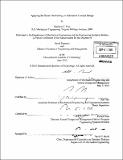| dc.contributor.advisor | Dan Frey. | en_US |
| dc.contributor.author | Frye, Matthew C. (Matthew Clinton) | en_US |
| dc.contributor.other | Massachusetts Institute of Technology. Engineering Systems Division. | en_US |
| dc.date.accessioned | 2012-02-24T20:52:59Z | |
| dc.date.available | 2012-02-24T20:52:59Z | |
| dc.date.copyright | 2010 | en_US |
| dc.date.issued | 2010 | en_US |
| dc.identifier.uri | http://hdl.handle.net/1721.1/69214 | |
| dc.description | Thesis (Nav. E.)--Massachusetts Institute of Technology, Dept. of Mechanical Engineering; and, (S.M. in Engineering and Management)--Massachusetts Institute of Technology, Engineering Systems Division, System Design and Management Program, 2010. | en_US |
| dc.description | Cataloged from PDF version of thesis. | en_US |
| dc.description | Includes bibliographical references (p. 71-72). | en_US |
| dc.description.abstract | Early stage ship design decisions continue to be a challenge for naval architects and engineers. The complex interactions between the different elements of the ship and the broad spectrum of disciplines required in ship design make it difficult to fully realize the effects and limitations early decisions place on design flexibility. Naval ship design has primarily focused on using point based design methods that do not necessarily produce the most cost effective, innovative, and high quality designs. Recognizing these shortcomings, U.S Navy design is exploring the use of Set Based Design (SBD) principles and methodology in designing the fleet for the 21st century. Existing research has shown the merits of SBD in other industries; however, research on the use of SBD in naval design does not exist. The thesis explores how to execute SBD in light of the recent restructuring of the U.S. Navy acquisition process calling for the use of SBD in pre-preliminary design. This is undertaken using the knowledge gained from exploration of the Ship-to-Shore Connector (SSC) program, the first use of SBD in a new start acquisition program. The thesis concludes by applying the derived information to an early stage submarine concept design. This effort focused on how to develop submarine design parameters and exploration of how to create and reduce integrated concepts. | en_US |
| dc.description.statementofresponsibility | Matthew C. Frye. | en_US |
| dc.format.extent | 94 p. | en_US |
| dc.language.iso | eng | en_US |
| dc.publisher | Massachusetts Institute of Technology | en_US |
| dc.rights | M.I.T. theses are protected by
copyright. They may be viewed from this source for any purpose, but
reproduction or distribution in any format is prohibited without written
permission. See provided URL for inquiries about permission. | en_US |
| dc.rights.uri | http://dspace.mit.edu/handle/1721.1/7582 | en_US |
| dc.subject | Mechanical Engineering. | en_US |
| dc.subject | Engineering Systems Division. | en_US |
| dc.title | Applying set based methodology in submarine concept design | en_US |
| dc.type | Thesis | en_US |
| dc.description.degree | S.M.in Engineering and Management | en_US |
| dc.description.degree | Nav.E. | en_US |
| dc.contributor.department | System Design and Management Program. | en_US |
| dc.contributor.department | Massachusetts Institute of Technology. Department of Mechanical Engineering | |
| dc.contributor.department | Massachusetts Institute of Technology. Engineering Systems Division | |
| dc.identifier.oclc | 707327136 | en_US |
